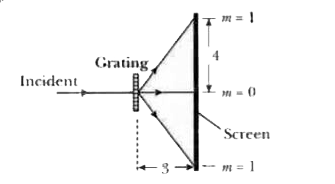Demonstrate that when light falls on a diffracting grating at right angles, the maximum resolving power of the grating cannot exceed the value l/λ, where l is the width of the grating and λ is the wavelength of light.
Using
R=λδλ=kN=Ndsinθλ
=lsinθλ≤lλ.
Topper's Solved these Questions
- BOOK - IE IRODOV, LA SENA & SS KROTOVCHAPTER - OPTICSEXERCISE - Polarization Of Light43videos
OPTICS
- BOOK - IE IRODOV, LA SENA & SS KROTOVCHAPTER - OPTICSEXERCISE - Dispersion And Absorption Of Light24videos
OPTICS
- BOOK - IE IRODOV, LA SENA & SS KROTOVCHAPTER - OPTICSEXERCISE - Interference Of Light33videos
OPTICS
- BOOK - IE IRODOV, LA SENA & SS KROTOVCHAPTER - MECHANICSEXERCISE - Mechanics Problems92videos
MECHANICS
- BOOK - IE IRODOV, LA SENA & SS KROTOVCHAPTER - OSCILLATIONS AND WAVESEXERCISE - Electromagnetic Waves, Radiation36videos
OSCILLATIONS AND WAVES
Similar Questions
Light with wavelength λ falls on a diffracting grating at right angles. Find the angular dispersion of the grating as a function of diffraction angle θ.
View SolutionThe ultimate resolving power λ/δλ of the spectrograph's trihedral prism is determined by diffraction of light at the prism edges (as in the case of a slit). When the prism is oriented to the least deviation angle in accordance with Rayleigh's criterion,
λ/δλ=b|dn/dλ|,
where b is the width of the prism's base (Fig.) and dn/dλ is the dispersion of its material. Derive this formula.
 View Solution
View Solution
Knowledge Check
- Question 1 - Select One
When light is incident on a diffraction grating, the zero order principal maximum will be
Aspectrum of the coloursBwhiteCone of the component coloursDabsent - Question 2 - Select One
A diffraction grating is ruled with 600 lines per millimetre. When monochromatic light falls normally on the grating, the first order diffracted beams are observed on the far side of the grating each making an angle of 15∘ with the normal to the grating.
What is the frequency of the light?A(a) 1.2×1013HzB(b) 4.7×1013HzC(c) 1.9×1014HzD(d) 7.0×1014Hz - Question 3 - Select One
In a spectrometer experiment, monochromatic light is incident normally on a diffraction grating having 4.5×105 lines per metre. The seond order line is seen at an angle of 30∘ to the normal. What is the wavelength of the light?
A(a) 200nmB(b) 556nmC(c) 430nmD(d) 589nm
Light with wavelength 530nm falls on a transparent diffraction grating with period 1.50μm. Find the angle, relative to the grating normal. At which the Fraunhofer maximum of highest order is observed provided the light falls on the grating
(a) at right angles,
(b) at the angle 60∘ to the normal.View SolutionA plane light wave with wavelength λ falls normally on a phase diffraction grating whose side view is shown in Fig. The grating is cut on a glass plate with refractive index n. Find the depth h of the lines at which the intensity of the central Fraunhofer maximum is equal to zero. what is in this case the diffraction angle corresponding to the first maximum?
 View Solution
View SolutionFind the wavelength of monochromatic light falling normally on a diffraction grating with period d=2.2μm if the angle between the directions to the Fraunhofer maxima of the first and the second order is equal to Δθ=15∘.
View SolutionA beam of monochromatic light of wavelength λ falls normally on a diffraction grating of line spacing d. If θ is the angle between the second-order diffracted beam and the direction of the incident light, what is the value of sinθ ?
View SolutionLight from a laser (λ=640nm) passes through a diffraction grating and spreads out into three beams as shown in the figure. Determine the spacing between the slits of the grating
 View Solution
View Solution

